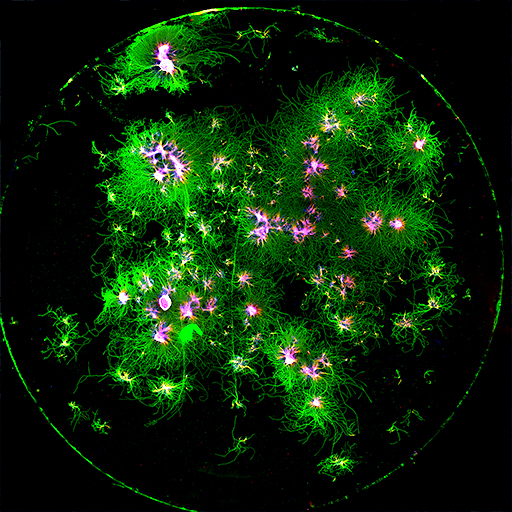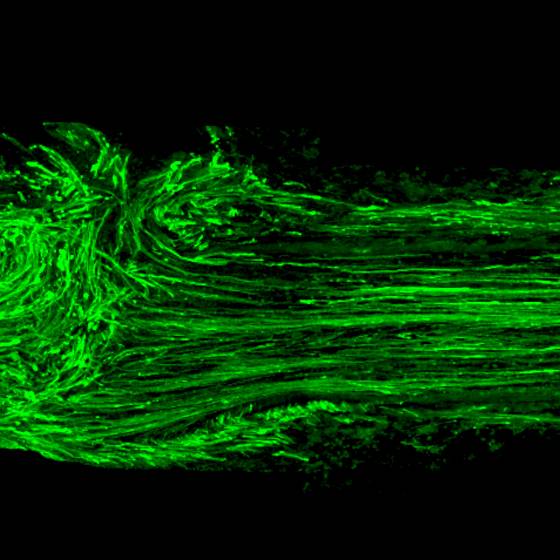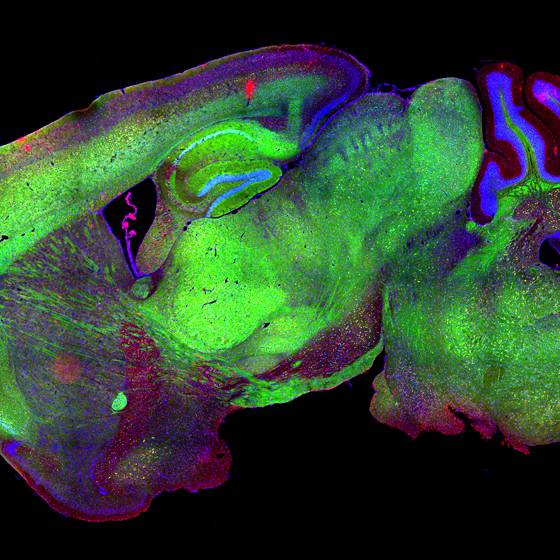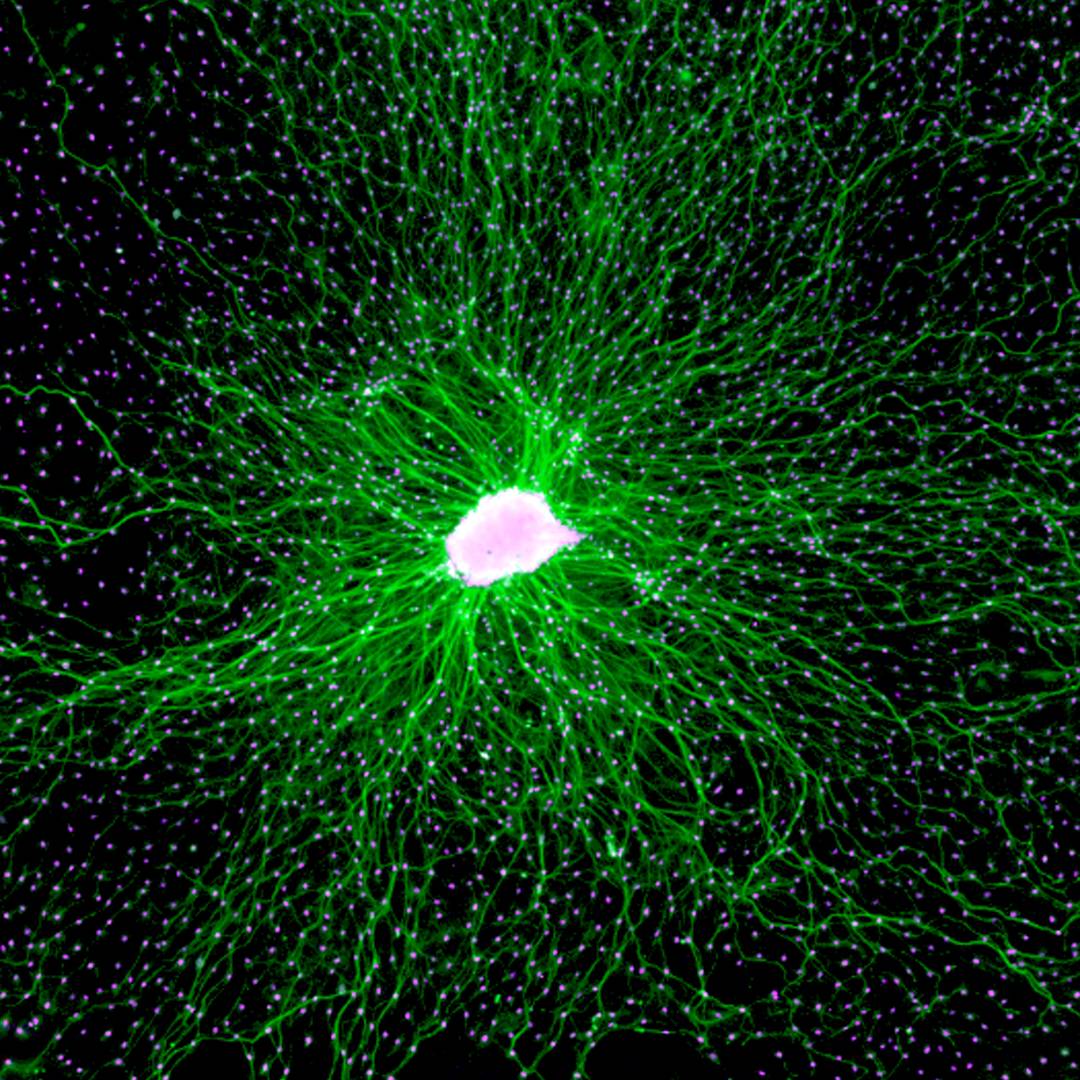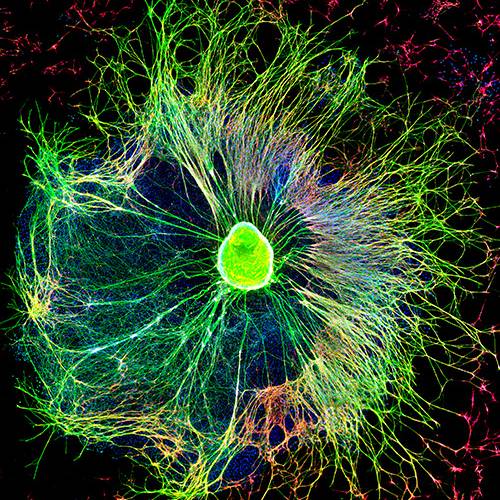Axonal Degeneration as a target for neuroprotection
Destruction programs are cellular mechanisms that have survival value when they operate under physiological control, but their malfunction could be deleterious for the organism. Apoptosis, or programmed cell death, is a well-known physiological destruction mechanism most apparent during development but persisting throughout the organism’s life. Other destruction programs are emerging as physiological processes that may not terminate in the destruction of the whole cell but only of restricted cellular domains. In the case of neurons, pruning of exuberant branches of terminal arborizations and degeneration of axons severed from their cell bodies are outstanding examples. Importantly, axonal degeneration is an early event in neurodegenerative condition including Alzheimer´s and Parkinson disease, as well as peripheral neuropathies. We are interested to define molecular players in the process of axonal degeneration to find therapeutic targets for neuroprotection.
Golgi staining of a mouse hippocampal section, with this technique, sparse neuronal labelling is obtained, which allows detailed analysis of individual neurons.

The degeneration of axons constitutes a salient feature shared by several neurodegenerative diseases that contributes to neuronal dysfunction and cell death. To date, the precise molecular and cellular mechanisms of axonal degeneration are under intense investigation. The morphological evidence indicates that axon degeneration as a consequence of aging and neurodegenerative diseases takes place in a retrograde fashion also known as dying back degeneration, which precedes cell death of the neuronal soma. Axon degeneration shares several characteristics with cell death by activation of the necroptotic signaling pathway, including mitochondrial dysfunction, ROS production, and intracellular calcium increase, and we have found that necroptosis inhibition by genetic or pharmacological means delays axonal degeneration in neurons from the peripheral and central nervous systems, as well as in model of Alzheimer´s and Parkinson Disease.
People involved

Macarena Arrazola
PI collaborator

PhD in Biological Sciences from the Catholic University of Chile. Studying the contribution of necroptosis in the age-associated axonal degeneration of the hippocampus, and the impact of using pharmacological approaches to revert neuronal dysfunction and cognitive impairment during aging, proposing necroptosis as an attractive target for the future development of geroprotective tools to treat age-related disabilities.

Daniela Rebolledo
Senior Research Assitant

BI am a Biochemist from Pontificia Universidad Católica de Chile (PUC) and PhD in Cell and Molecular Biology from the same university. My PhD thesis research was performed at the Physiology and Biophysics department, University of Washington. My research has focused on the physiology of the neuromuscular system and the pathological mechanisms behind neuromuscular disorders of diverse etiology.

Laura Gomez
Research Assitant

Medical Technologist from the U. Mayor. With experience in histological techniques, immunohistochemistry, immunofluorescence, biochemistry and molecular biology techniques. I am currently working on the role of RIPK3 in axonal degeneration in genetic models of Parkinson’s Disease , through Michael J. Fox’s project.

Rodrigo Leiva
Research Assitant

B.Sc(hons) degree in Neuroscience from the University of Glasgow and M.Sc in Integrative Neuroscience from the University of Edinburgh. I’m currently working on the role of axonal necroptosis and inflammation in the dopaminergic neurons of the nigrostriatal pathway in Parkinson’s Disease to assess it as a potential therapeutic target through the inhibition of RIPK3.
Related Publications
PUBLICATIONSDataPNSNeuroDegeneration
octubre 4, 2021
Diapause formation and downregulation of Insulin-like signaling via DAF-16/FOXO delays axonal degeneration and neuronal loss.
Calixto A, Jara JS, Court FA.
PLoS Genet. 2012;8(12):e1003141. doi: 10.1371/journal.pgen.1003141. Epub 2012 Dec 27.
PMID: 23300463
PUBLICATIONSReviewPNSCNSNeuroDegeneration
octubre 4, 2021
Mitochondria as a central sensor for axonal degenerative stimuli.
Court FA, Coleman MP.
Trends Neurosci. 2012 Jun;35(6):364-72. doi: 10.1016/j.tins.2012.04.001. Epub 2012 May 11.
PMID: 22578891
PUBLICATIONSReviewNervous System FxPNSCNS
octubre 4, 2021
Slow axoplasmic transport under scrutiny.
Court FA, Alvarez J.
Biol Res. 2011;44(4):311-21. Epub 2012 Feb 10.
PMID: 22446593
octubre 4, 2021
Chronic intermittent hypoxia-induced vascular enlargement and VEGF upregulation in the rat carotid body is not prevented by antioxidant treatment.
Del Rio R, Muñoz C, Arias P, Court FA, Moya EA, Iturriaga R.
Am J Physiol Lung Cell Mol Physiol. 2011 Nov;301(5):L702-11. doi: 10.1152/ajplung.00128.2011. Epub 2011 Aug 5
PMID: 21821731
Related News
Investigador del CIB expuso en congreso internacional sobre envejecimiento realizado en Valdivia
octubre 14, 2021
El Dr. Felipe Court y la Dra. Macarena Arrázola, postdoctorante del Centro, demostraron que inhibiendo una vía celular llamada necroptosis, se puede retrasar la pérdida de memoria. El director del…
U. Mayor se adjudica $240 millones y se convierte en la única institución privada entre los ganadores del Fondequip
octubre 14, 2021
El proyecto, presentado por académicos del Centro de Biología Integrativa, fue uno de los 28 seleccionados entre 168 postulantes, y permitirá adquirir un microscopio de última generación, que además…




